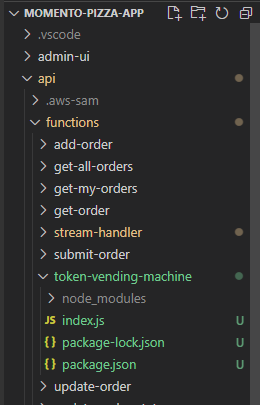Code changes for the TVM
A token vending machine (TVM) is a piece of server-side code responsible for creating short-lived, limited-scope auth tokens. These tokens are intended to be used in the front-end of an application. Since the tokens will be sent to an end user’s browsing session, there is potential for the token to be intercepted and the session could be compromised. We set the tokens to expire automatically after a short time, limiting the exposure and improving our security.
Creating the Lambda function
Once again, we need to create a new Lambda function. This process will be identical to how we created the stream handler function.
- Create a new folder in the
/api/functionsdirectory called `token-vending-machine
mkdir functions/token-vending-machine
- Create a new file called
index.jsin the token-vending-machine folder
touch functions/token-vending-machine/index.js
- In your terminal, navigate to the new folder with the following command (assuming you are in the
/apidirectory already)
cd functions/token-vending-machine
- To initialize a new
package.jsonfile, run the following command and walk through the prompts using the default values
npm init
- Now we need to install the required packages, so run this command in the terminal:
npm install @gomomento/sdk @aws-sdk/client-secrets-manager --save-dev
- You should have a folder structure that looks like this:

- Copy and paste the following code into the
index.jsfile:
const { AuthClient, CacheClient, Configurations, CacheGet, CredentialProvider, ExpiresIn, GenerateAuthToken, TopicRole, AllTopics } = require('@gomomento/sdk');
const { SecretsManagerClient, GetSecretValueCommand } = require('@aws-sdk/client-secrets-manager');
const secrets = new SecretsManagerClient();
let authClient;
let cacheClient;
exports.handler = async (event) => {
try {
await initializeMomento();
const ipAddress = event.requestContext.identity.sourceIp;
const cacheResponse = await cacheClient.get('pizza', `${ipAddress}-token`);
if (cacheResponse instanceof CacheGet.Hit) {
return {
statusCode: 200,
body: cacheResponse.valueString(),
headers: { 'Access-Control-Allow-Origin': '*' }
};
} else {
const tokenScope = {
permissions: [
{
role: TopicRole.SubscribeOnly,
cache: 'pizza',
topic: AllTopics
}
]
};
const token = await authClient.generateAuthToken(tokenScope, ExpiresIn.hours(1));
if (token instanceof GenerateAuthToken.Success) {
const vendedToken = JSON.stringify({
token: token.authToken,
exp: token.expiresAt.epoch()
});
await cacheClient.set('pizza', `${ipAddress}-token`, vendedToken);
return {
statusCode: 200,
body: vendedToken,
headers: { 'Access-Control-Allow-Origin': '*' }
};
} else {
throw new Error('Unable to create auth token');
}
}
} catch (err) {
console.error(err);
return {
statusCode: 500,
body: JSON.stringify({ message: 'Something went wrong' }),
headers: { 'Access-Control-Allow-Origin': '*' }
};
}
};
const initializeMomento = async () => {
if (cacheClient && authClient) {
return;
}
const secretResponse = await secrets.send(new GetSecretValueCommand({ SecretId: process.env.SECRET_ID }));
const secret = JSON.parse(secretResponse.SecretString);
cacheClient = new CacheClient({
configuration: Configurations.InRegion.Default.latest(),
credentialProvider: CredentialProvider.fromString({ authToken: secret.momento }),
defaultTtlSeconds: 3300
});
authClient = new AuthClient({
credentialProvider: CredentialProvider.fromString({ authToken: secret.momento })
});
};
Like last time, we’ll walk through this on the next page. But for now, let’s finish up making the code changes.
Template updates
We need make an update to the template.yaml file to include our new function. This time though, our Lambda function is backing two API endpoints, so our structure looks a little different than it did with the stream handler.
TokenVendingMachineFunction:
Type: AWS::Serverless::Function
Properties:
CodeUri: functions/token-vending-machine
Policies:
- AWSLambdaBasicExecutionRole
- Version: 2012-10-17
Statement:
- Effect: Allow
Action:
- secretsmanager:GetSecretValue
Resource: !Ref MomentoSecret
Events:
AdminApi:
Type: Api
Properties:
RestApiId: !Ref AdminApi
Path: /tokens
Method: GET
OrderApi:
Type: Api
Properties:
RestApiId: !Ref OrderApi
Path: /tokens
Method: GET
The code above should be pasted into the Resources section of the template.yaml file.
You see here there are two events listed in this resource definition. This means that if someone hits the GET /tokens endpoint in either the Admin Api or the Order Api, our function will be triggered.
Api definition updates
Our Apis are defined in Open API Specification files. The Admin Api is located at /api/admin-openapi.yaml and the Order AApi is at /api/order-openapi.yaml. We need to make the following change to both specifications.
/tokens:
get:
summary: Gets a temporary, limited-scope token for use in a browser
tags:
- Auth
responses:
200:
description: A token was generated and returned to the caller
content:
application/json:
schema:
type: object
properties:
token:
type: string
exp:
type: Number
500:
$ref: '#/components/responses/UnknownError'
x-amazon-apigateway-request-validator: Validate All
x-amazon-apigateway-integration:
uri:
Fn::Sub: arn:${AWS::Partition}:apigateway:${AWS::Region}:lambda:path/2015-03-31/functions/${TokenVendingMachineFunction.Arn}/invocations
httpMethod: POST
type: aws_proxy
This entire code block goes inside the paths block in both files.
This definition is enabling SAM to create the necessary permissions and connections for API Gateway to our Lambda function. A cool note here - if we were defining a POST endpoint with a request body, SAM would automatically generate validation models and check schemas for us at API Gateway, freeing our function code up from doing manual validations!
Deploy
With these changes in place, it’s time to deploy our changes and verify we can get a short-lived token. Run the following commands in a terminal at the /api directory:
sam build
sam deploy
To test, we need to take the base urls from the output of our deployment and run them through a curl command via the terminal (or something like Postman, if that’s your preference). Remember the URLs from the deployment output? They looked a bit like this…

curl '<OrderApiEndpoint>/tokens'
curl '<AdminApiEndpoint>/tokens'
If all goes to plan, you should recieve a response like this:

Now we’re good to go! Let’s take a step back for a minute and go through the function code on the next page so we know what we just built 👉